This may be remembered as the year of the bee at Curbstone Valley. It started when we installed a few hives of honey bees on the farm this spring, but we also greatly understand the importance of the native bees that frequent our crops and flowers.
Research has demonstrated that diversification of pollinators is critical for farms, and that organic farms situated close to wild-land habitats may depend more on native bees for pollination, than conventional farms. Most conventional farms are almost wholly dependent on European honey bees for pollination as they lack the habitat necessary to sustain native pollinators. [1]
Here we’re striving to do what we can to support both our honey bees, and our native bee populations.
It’s important to recognize that many of the same threats to honey bee populations, including some diseases [2], and risks from exposure to pesticides, may have similar detrimental effects on native bee populations.
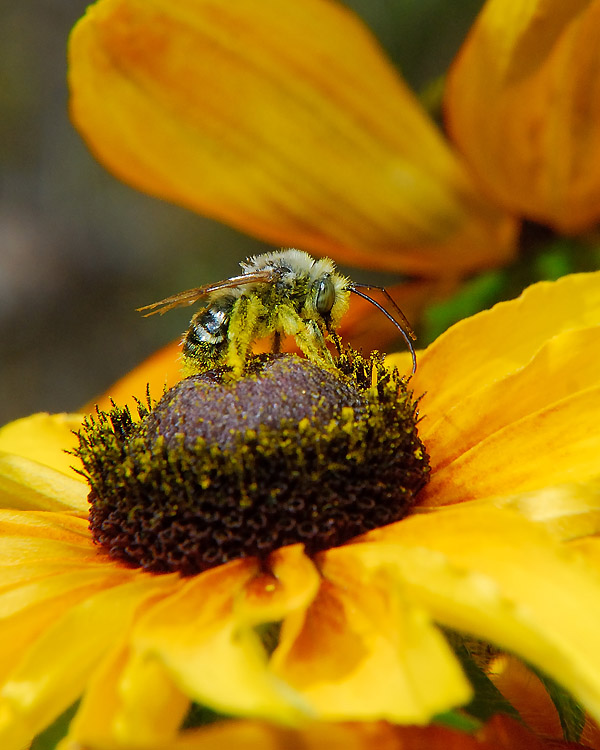
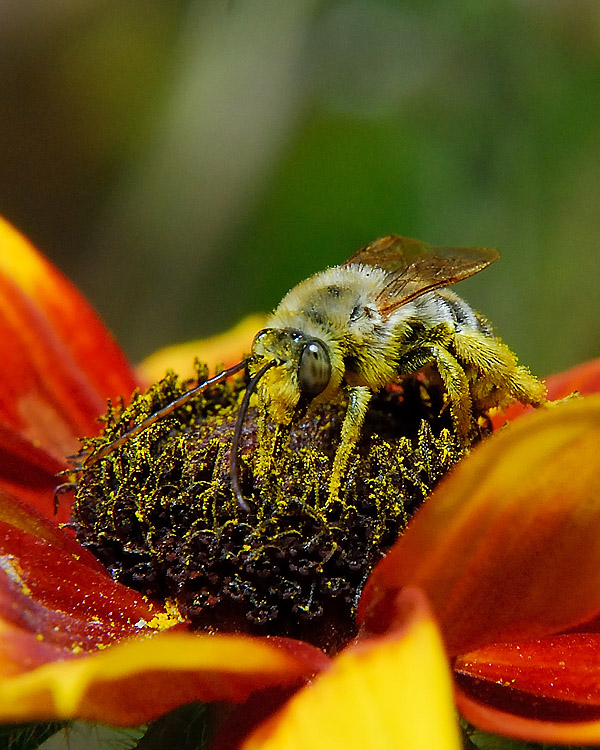
The most obvious single threat to native bees, however, is habitat degradation.
Native bee populations co-evolved with regionally adapted native plant species, which tend to become sparse in populated areas, where landscapers, and gardeners select plants for their aesthetic value, and farmers choose plants solely for their economic value, rather than their importance to the survival of native pollinator species.
Approximately 1600 native bee species have been recorded in California [3]. We’ve noticed a number of native bees here in the last couple of years, including green sweat bees (Agapostemon spp.), carpenter bees (Ceratina and Xylocopa spp.), bumble bees (Bombus spp.), leaf cutter bees (Megachile spp.), and now, these intriguing looking long-horn bees (Melissodes, Diadasia, or Svastra, spp. — trust me, unless you’re an entomologist, this group of bees can be tricky to nail down a definitive ID).
Long-horn bees are in the family Apidae, and the tribe Eucerini. By recognizing some of the different native bees present on the property, and learning about their foraging habits, nesting habits, and significance as pollinators, we can ensure that we take the necessary steps to encourage, and support, their populations on the farm.
Until this summer we hadn’t noticed any long-horn bees in the gardens, perhaps because the gardens didn’t hold much of interest to these particular bees. Many long-horned bees are specialist foragers, targeting only plants in the Asteraceae family, such as our native Asters, and Encelia, as well as our garden Sunflowers, and Rudbeckias. In fact long-horn bees are one of the key native bee species for pollinating commercial sunflower crops [4].
Although we’re not exactly sure which species of long-horn bee this is, the Rudbeckias, and sunflowers we’ve planted this year near the greenhouse, seem to be enticing these particular bees. Our best educated guess is that this bee might be Melissodes robustior, one of the most common long-horn bee species in California. Regardless, once the sun’s rays hit these blooms in the morning, it’s almost impossible to miss these bees. I almost feel as if I owe the bees an apology for not planting the Rudbeckias sooner.
Long-horn bees range from from 7.5 to 18 mm in length. Male long-horn bees have remarkably long antennae, as shown in some of these photographs, for which they acquired their common moniker, and an elongated body shape. Whereas females have shorter antennae, and a more rounded body shape.
In addition to long antennae, the most notable physical characteristic of these bees is that their legs are significantly more hairy than their honey bee cousins.
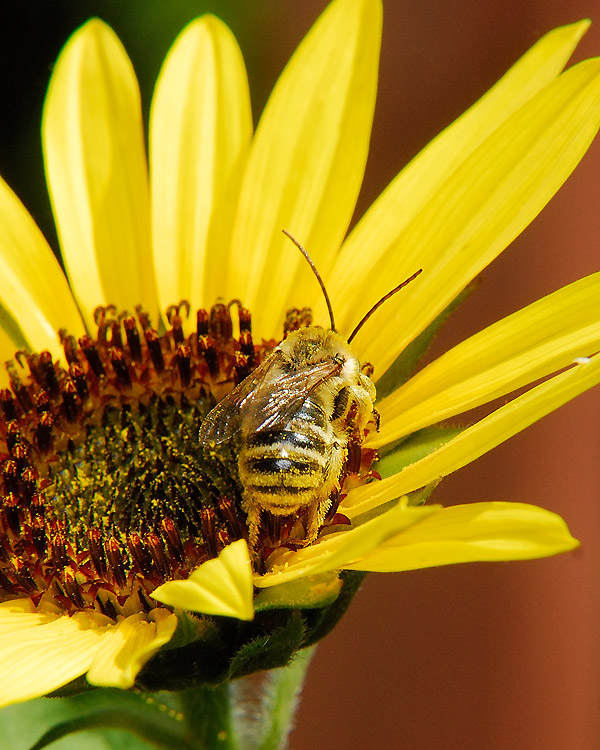
The females are responsible for gathering pollen on their brush-like leg hairs (scopae), as well as foraging for nectar, and depositing food in their underground nests to sustain developing larvae.
Any native-bee-friendly garden is only enhanced by planting a diversity of nectar and pollen-rich native, and heirloom flowers. However, suitable nesting sites are also critical for helping to sustain native bee populations. Native bees don’t live in hives like their honey bee counterparts, and many species construct underground nests. Desirable nesting sites, and nests however, can easily be damaged, or destroyed, as a result human activity.
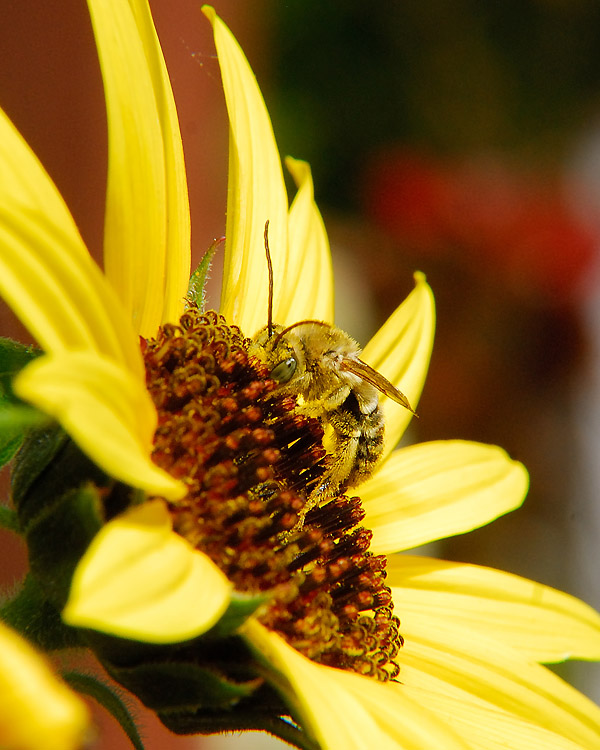
To encourage native ground-nesting bees, it’s important that some areas of bare soil are left in the gardens. Although mulches are important for conserving moisture for plants, and improving soil texture, mulching every square inch of garden space eliminates important nesting habitat for ground-nesting native bees.
Here we mulch individual plants, not entire surfaces, mostly our vegetables and fruits, to avoid providing too much cover for ravenous rodents, like our meadow voles.
For any ground nesting bee species it’s also imperative that nesting sites aren’t disturbed, as these bees spend much of their lives developing underground, many only emerging to mate and forage for a few short weeks each year. One of the worst gardening practices for ground nesting bees, other than the obvious use of pesticides, is rototilling garden soils. This not only destroys soil structure, but can also destroy nests.
Next time you consider reaching for the rototiller, ask yourself, do you have ground nesting bees, like these long-horn bees, in your garden? Hand digging is not only healthier for the gardener, but it’s also better for the bees!
Although we’ve been judicious about planting flowers in the Asteraceae family, as generally they tend to cause the rapid crystallization of honey, the fact these long-horn bees seem to favor plants in this family, highlights the importance of planting a diverse variety of flowers in the gardens. With careful planning we hope to keep both the honey bees, and the native bees happy.
Next time you think you see a honey bee in the garden, take a closer look, it may in fact turn out to be a native bee!
To learn more about identifying, and providing suitable habitat for native bees, see:
California Pollinator Project: Citizen Scientist Pollinator Monitoring Guide
Farming For Bees: Guidelines for Providing Native Bee Habitat on Farms
——————
[1] Kremen, C. et a. 2004. The Area Requirements of an Ecosystem Service: Crop Pollination by Native Bee Communities in California. Ecology Letters. Vol: 7 p. 1109-1119.
[2] Singh R, Levitt AL, Rajotte EG, Holmes EC, Ostiguy N, et al. 2010 RNA Viruses in Hymenopteran Pollinators: Evidence of Inter-Taxa Virus Transmission via Pollen and Potential Impact on Non-Apis Hymenopteran Species. PLoS ONE 5(12)
[3] Frankie, G.W., et al. Native Bees Are a Rich Natural Resource in Urban California Gardens. July-September 2009. UCANR Publication.
[4] Xerces Society Fact Sheet: Native Bee Pollination of Hybrid Sunflowers.

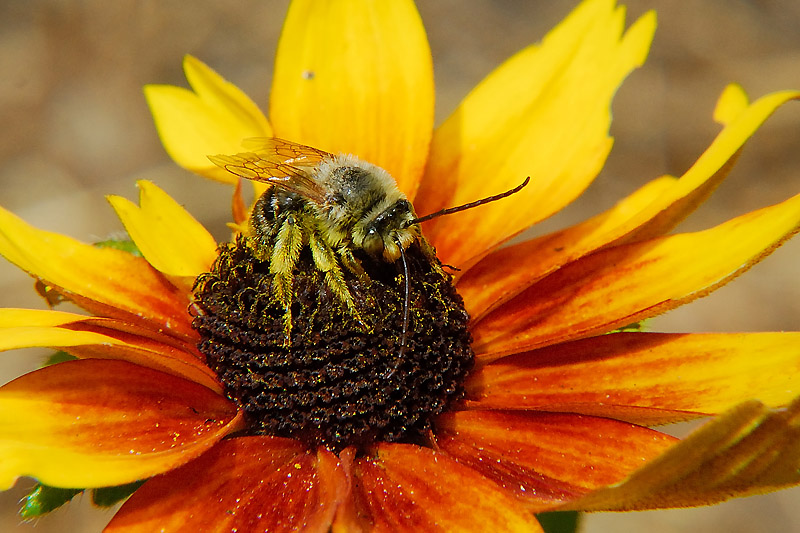

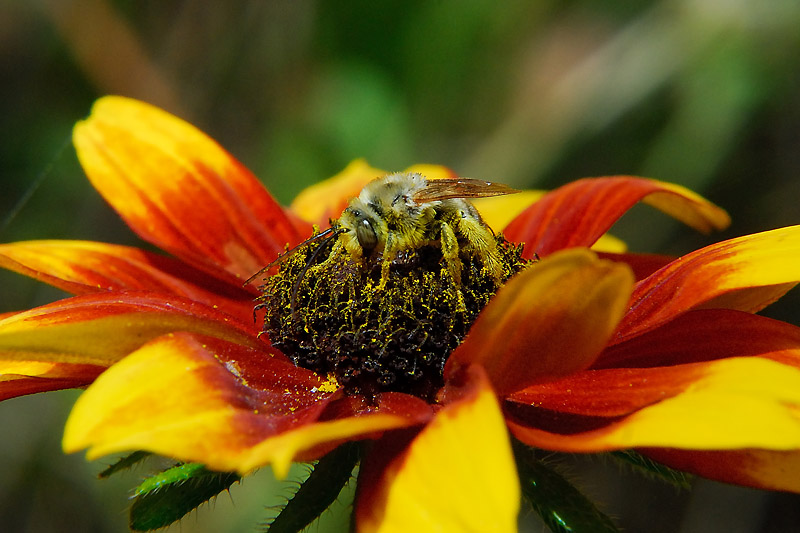
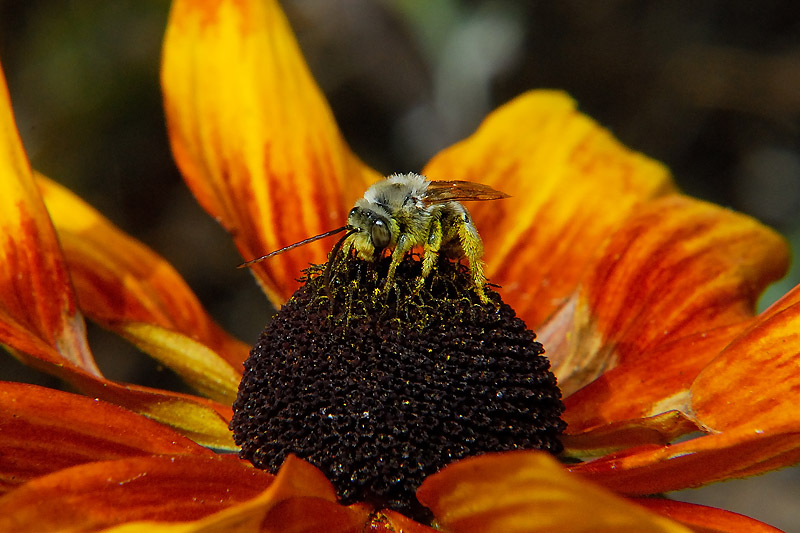
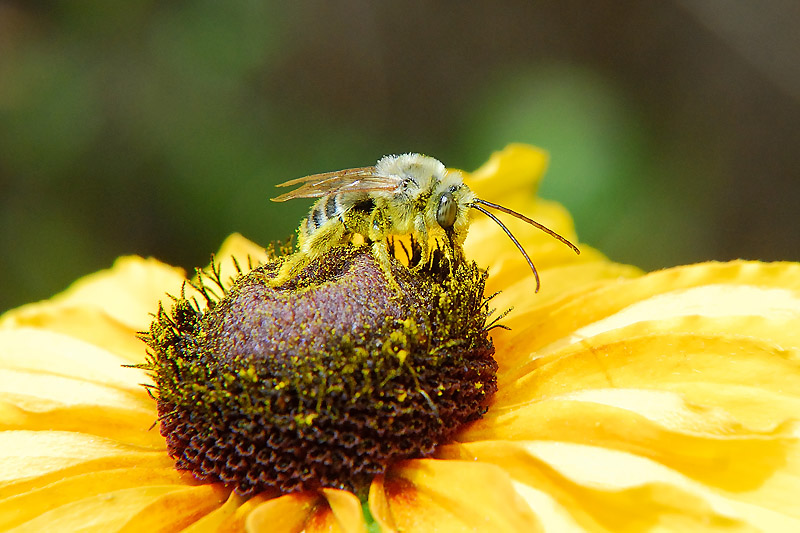

Great photos!
Love those hairy legs.
At least their ankles won’t freeze in winter 😉
What an ususual looking bee. I haven’t noticed any but honey bees and we haven’t discovered where they may have their hives. Syrphid flies are what we have attracted to the Rudbeckia here.
Another good reason to have some bare ground is for quail who we watch having their dust baths. So cute to watch.
Nice to know about the long horned bee.
They really are quite unique bees. Although from a distance you could mistake them for honey bees. They fly somewhat more more erratically though!
Clare,
Never heard of these bees before, they look a lot like honey bees. It was in the 60s here today, the bees stayed inside. I have a new bottom board to install it is a small hive beetle trap, anything that falls to the bottom of the hive and gets past the screen drowns in cooking oil. The screen keeps the bees out. Oh, not buying that house Meg would like to live closer to town.
Honestly, I didn’t know much about them either. I’m sure I’m much the wiser the now. I was ‘convinced’ I had a conclusive ID on this bee, on at least three occasions, in three different genera! Settling on long-horned bee seemed the most accurate though 😉
Shame about the house, I’d love to see it all restored!
Now I know what type of bee was nesting in the Gilia capitata I had in the garden earlier. I got really clear pictures of them but it seems impossible to find information of different bee species online.
I was also taking seed from and pruning back some Red Mask flower and pulled out one flower stalk, was about to run my hand up the stalk to rub off the seed pods and luckily saw a curled up little bee! The same species! When I took out the dead Gilia, one must have moved to the mask flower. And just like the others, he seemed completely senseless, doped in an groggy sleep. I had to prod him with another stem and push him off onto another plant for him to move to safety.
Oh! I just dropped by your blog, and saw your bees on the Gilia. I haven’t been paying enough attention late in the day, or in the very early mornings. I’d read that the males, as they have no hives to go to, will congregate on some of their preferred flowers to sleep at night. Safety in numbers I suppose. I haven’t seen this yet for myself, but made a mental note to keep an eye out for it. I love your photo, it’s just as sounded in the descriptions I read. I think they end up in a bit of a stupor overnight when the temperatures drop, but once they warm up, they move along, and resume zipping around the flowers!
Oh, you’re killing me!!!! I have wanted to see one of those guys since the moment I heard of them.
I’ve got a lovely, lively native bee working my lavender, but she’s too quick to photograph! I’d love to figure her out.
These long-horns weren’t easy to photograph. They tend to dart around from flower to flower, and only alight for a few seconds. I spent quite some time practically sitting in a native rose bush to get these. Next time I need to wear to thicker trousers. 😀 I hope you can capture a snap of your native bee, I’d love to see who she is.
Very informative post! I am learning more about the bees in my garden all the time and will have to look very closely to see if I have any long-horn bees. Thanks for sharing your expertise!
There seem to be long-horn bee species all across the country, so I’ll be curious to see if you find some. Here they really seem to prefer our sunflowers, but most of their blooms are finishing for the season. They seem content with the Rudbeckia as an alternate though, but two of Rudbeckia varieties go mostly ignored, including R. fulgida, which surprised me.
I find your writing to be so interesting and informative. I will look for the long horned bees on my sunflowers and rudebeaka. I have a large stand of both. I did not know that bees will nest underground, so how do you know that there is a nest in the garden?
It somewhat depends on the species. Generally digger bee nests may look as simple as a hole in the ground, with a fine short mound of soil near the entrance, or more elaborate with a short turret at the entrance. There’s a little video clip on YouTube of bees entering a ground nest: http://www.youtube.com/watch?v=hW8tB6hkqyU
It’s a little shady, but you can see the entrance is just a small hole in the ground!
I certainly hope everyone looked at the larger sized images – absolutely gorgeous. I could stare into those green eyes all day.
I think that’s why I took so many photos, their eyes fascinate me too! 😉
Clare, I always learn so much from your blog (even without the footnotes, which are certain to warm the heart of any academic!) I’m adding bees to the list of things I need to learn more about.
I’m a footnote stickler 😉 I’m one of those geeks that wants to know the source. I too need to learn more about bees, especially our native ones. I’m hoping as the garden grows that we’ll see more species, which will prompt me to learn more about their habits too! I must admit, I’m quite taken with these little long-horns.
This is a very informative and wonderful photos to go with the copy. I really enjoyed your post. Our farm is like you mentioned, next to protected natural habitat and we get many different kinds of bees pollinating the crops.
Smaller farms I think certainly have the advantage when it comes to native pollinators. We have a lot of ‘big ag’ land in the county, and when you drive through those areas, the lack of hedgerows and natural plant borders is so apparent, it almost looks sterile. It makes me realize how fortunate we are, both of us, to have some wild-land habitat so close.
I never heard of Long-Horn Bees. They are rather cute, if you can say a bee is cute. The males longer antennae and the furry legs give them a different appearance, plus they look a little green. Thanks for all the info on them. I don’t know if we have them here, but I am going to ‘bee’ on the lookout.
I think they’re cute too…sort of the teddy bears of small bees. They do look interesting in color. I think their ‘fur’ is naturally a pale light tan color, but they get so covered in pollen they can end up looking quite colorful!
I have noticed more bees and other pollinators this year especially because I have made an effort to not till soil, to plant natives and to not use chemicals. I love your bee posts because I learn so much. I hope to learn more about native bees in my area as well…
I love walking into established gardens that have been pesticide free for an extended period, and have made the effort to plant with pollinators in mind. It’s amazing how lively some of those gardens can be. With just a little effort, and we’ve done nothing herculean here, the bees and butterflies just seem to show up! I can only imagine how our gardens might be in 5 years, and I can’t wait to see it for myself!
I have never heard of the Longhorn bee! And I didn’t realize so many bees nested under the ground, either. I also didn’t realize there were so many different types of bees! Amazing! I always learn something new when I read your posts.
I think, if I recall correctly, that there are some 4,000 species of native bees in the United States. California is very lucky to have so many species here, no doubt due in part to mild climate. I hadn’t heard of long-horn bees either until I saw them in the garden, and just HAD to know who they were 🙂 I’m glad they’re here, and hope to see some more of their bee cousins in the gardens over the coming seasons.
My favorite “Bee Whisperers” – it’s always a great entomology lesson when I stop by! It has been because of your blog that I was very deliberate in my plant choices this year. Here at ‘the Bunnies Buffet’, I’ve added Bee Balm and Butterfly Bush to catch more of the Summer season with blooms that the bees enjoy. PJM Rhododendron makes them happy in the Spring and the large patch of Rudibeckia catches them later in the season. (To think 7 years ago – all I had was grass & a few trees??)
I expect you’ve noticed many more bees and butterflies as a result of diversifying the plant species in your garden too. I find it rather addictive. This flower attracts that butterfly, or this bee, and then I find myself planting something else to see who shows up! This year we let a lot of fennel bloom in the vegetable garden, easy to start from seed, and the range of pollinators that visit fennel flowers is just remarkable! It doesn’t take much to entice them, but they’re so fun to watch.
Clare, as usual you’ve included lots of great information on a topic I knew nothing about before. Last year we had bees nesting under our shed. I had no idea they would nest in the ground, I keep looking for nests in trees!
That all depends on the bee, although that said, I have even seen honey bees build nests in strange places. A number of native bees nest underground though, and some species may nest either in a tree or underground, depending on what suitable sites are available. Now you’ll have to look for nests on the ground as well as in the trees! 😉
Wow – the larger images really show off the unique appearance of the longhorn bees! These are bees with character! My husband recently asked me why I haven’t planted sunflowers. Now I know I must! I don’t know that we have longhorns here, but I am sure lots of little creatures would appreciate the sunflowers.
Always a wealth of information, dear Clare. No wonder you are blessed with the bounty of bees!